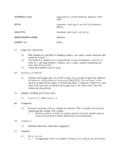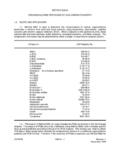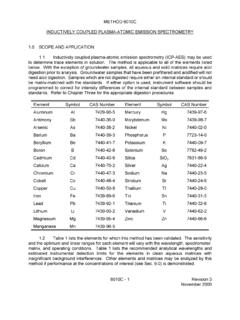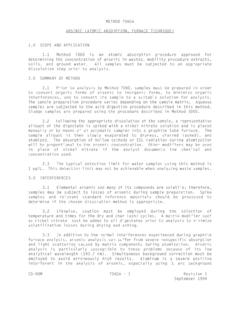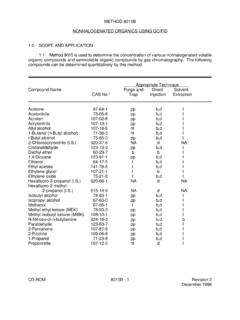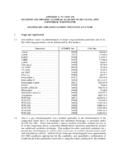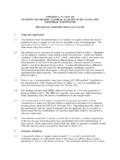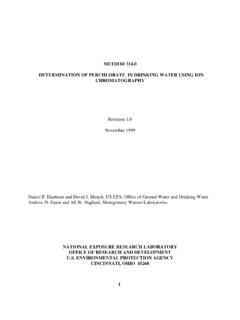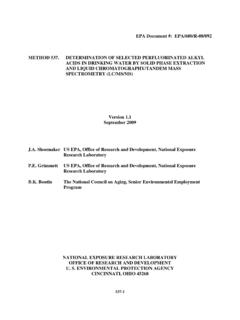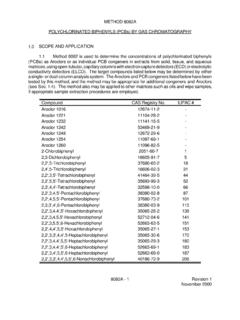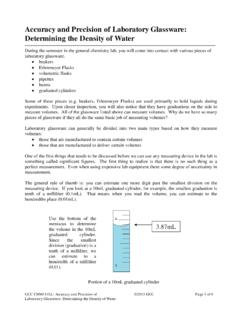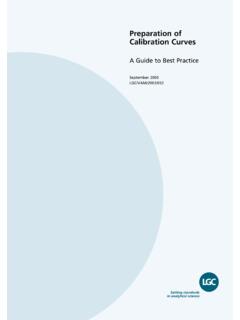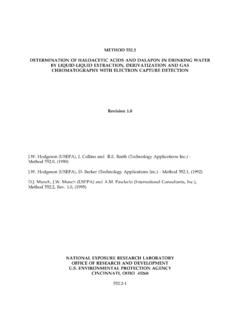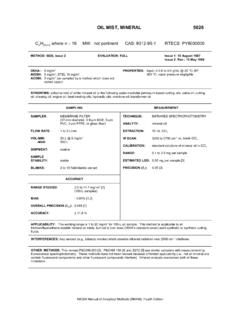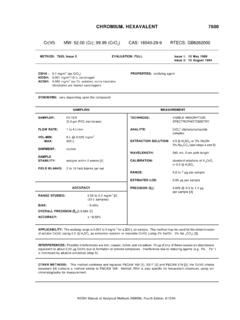Transcription of EPA Method 552.3 - Determination of Haloacetic Acids and ...
1 Method Determination OF Haloacetic Acids AND DALAPON IN. DRINKING WATER BY liquid - liquid microextraction , derivatization , and gas chromatography WITH. ELECTRON CAPTURE DETECTION. EPA 815-B-03-002. Revision July 2003. M. M. Domino and Pepich (Shaw Environmental and Infrastructure, Inc.). Munch and Fair (US EPA, Office of Ground Water and Drinking Water). Y. Xie (Penn State University). Munch, Munch (US EPA, Office of Ground Water and Drinking Water) and A. M. Pawlecki- Vonderheide (ICI) Method , Revision (1995). Hodgeson (USEPA), D. Becker (Technology Applications, Inc.) Method , (1992). Hodgeson (USEPA), J. Collins and R. E. Barth (Technology Applications, Inc.) Method , (1990). TECHNICAL SUPPORT CENTER. OFFICE OF GROUND WATER AND DRINKING WATER. U. S. ENVIRONMENTAL PROTECTION AGENCY. CINCINNATI, OHIO 45268. Method Determination OF Haloacetic Acids AND DALAPON IN DRINKING WATER BY. liquid - liquid microextraction , derivatization , AND GAS.
2 chromatography WITH ELECTRON CAPTURE DETECTION. 1. SCOPE AND APPLICATION. This is a gas chromatography (GC) Method for the Determination of Haloacetic Acids and dalapon in drinking waters. Accuracy, precision, and Detection Limit (DL) data are presented for the following compounds in reagent water and finished ground and surface waters. Chemical Abstracts Service Analyte (CAS). Registry Number Bromochloroacetic acid (BCAA). 5589-96-8. Bromodichloroacetic acid (BDCAA). 71133-14-7. Chlorodibromoacetic acid (CDBAA). 5278-95-5. Dalapon 75-99-0. Dibromoacetic acid (DBAA). 631-64-1. Dichloroacetic acid (DCAA). 79-43-6. Monobromoacetic acid (MBAA). 79-08-3. Monochloroacetic acid (MCAA). 79-11-8. Tribromoacetic acid (TBAA). 75-96-7. Trichloroacetic acid (TCAA). 76-03-9. Detection Limits are compound, instrument, and matrix dependent. The DL is defined as the statistically calculated minimum amount that can be measured with 99% confidence that the reported value is greater than zero.
3 (1) Detection Limits for the above listed analytes are provided in Section 17, Table 5. The DL differs from, and is lower than, the Minimum Reporting Level (MRL) (Sect. ). The concentration range for target analytes in this Method was evaluated between g/L and 30 g/L for a 40-mL sample. Precision and accuracy data are presented in Section 17, Tables 6-11. This Method is restricted to use by or under the supervision of analysts skilled in liquid - liquid extractions, derivatization procedures and the use of GC and interpretation of gas chromatograms. 2. SUMMARY OF Method . A 40-mL volume of sample is adjusted to a pH of or less and extracted with 4 mL of either methyl tert-butyl ether (MTBE) or tert-amyl methyl ether (TAME) containing an internal standard. The Haloacetic Acids that have been partitioned into the organic phase are then converted to their methyl esters by the addition of acidic methanol followed by heating for 2.
4 Hours. The solvent phase containing the methylated Haloacetic Acids is separated from the acidic methanol by adding 7 mL of a concentrated aqueous solution of sodium sulfate. The aqueous phase is discarded. The extract is then neutralized with a saturated solution of sodium bicarbonate and the solvent layer is removed for analysis. The target analytes are identified and quantified by capillary column gas chromatography using an electron capture detector (GC/ECD). Analytes are quantified using procedural standard calibration. 3. DEFINITIONS. EXTRACTION BATCH A set of up to 20 Field Samples (not including calibration standards and QC samples) extracted together by the same person(s) during a work day using the same lots of solvents, surrogate solution, and fortifying solutions. Required QC. samples include a Laboratory Reagent Blank, Laboratory Fortified Matrix, either a Field Duplicate or Laboratory Fortified Matrix Duplicate and an appropriate number of Continuing Calibration Checks.
5 ANALYSIS BATCH A set of samples that is analyzed on the same instrument during a 24-hour period that begins and ends with the analysis of the appropriate Continuing Calibration Check standards (CCC). Additional CCCs may be required depending on the length of the analysis batch and/or the number of Field Samples. INTERNAL STANDARD (IS) A pure analyte added to an extract or standard solution in a known amount and used to measure the relative responses of other Method analytes and surrogates. The internal standard must be an analyte that is not a sample component. SURROGATE ANALYTE (SUR) A pure analyte, which chemically resembles target analytes and is extremely unlikely to be found in any sample. This analyte is added to a sample aliquot in a known amount before extraction or other processing, and is measured with the same procedures used to measure other sample components. The purpose of the SUR is to monitor Method performance with each sample.
6 LABORATORY REAGENT BLANK (LRB) An aliquot of reagent water or other blank matrix that is treated exactly as a sample including exposure to all glassware, equipment, solvents, reagents, sample preservatives, internal standards, and surrogates that are used in the extraction batch. The LRB is used to determine if Method analytes or other interferences are present in the laboratory environment, the reagents, or the apparatus. LABORATORY FORTIFIED BLANK (LFB) An aliquot of reagent water or other blank matrix to which known quantities of the Method analytes and all the preservation compounds are added. The LFB is analyzed exactly like a sample, and its purpose is to determine whether the methodology is in control, and whether the laboratory is capable of making accurate and precise measurements. LABORATORY FORTIFIED SAMPLE MATRIX (LFSM) An aliquot of a Field Sample to which known quantities of the Method analytes and all the preservation compounds are added.
7 The LFSM is processed and analyzed exactly like a sample, and its purpose is to determine whether the sample matrix contributes bias to the analytical results. The background concentrations of the analytes in the sample matrix must be determined in a separate aliquot and the measured values in the LFSM corrected for background concentrations. LABORATORY FORTIFIED SAMPLE MATRIX DUPLICATE (LFSMD) A second aliquot of the Field Sample used to prepare the LFSM which is fortified, extracted and analyzed identically to the LFSM. The LFSMD is used instead of the Field Duplicate to access Method precision and accuracy when the occurrence of a target analyte is infrequent. LABORATORY DUPLICATES (LD1 and LD2) Two aliquots of the same sample split in the laboratory and analyzed separately with identical procedures. Analyses of LD1 and LD2 indicate precision associated with laboratory procedures, but not with sample collection, preservation, and storage procedures.
8 FIELD DUPLICATES (FD1 and FD2) Two separate samples collected at the same time and place under identical circumstances, and treated exactly the same throughout field and laboratory procedures. Analyses of FD1 and FD2 give a measure of the precision associated with sample collection, preservation, and storage, as well as with laboratory procedures. STOCK STANDARD SOLUTION (SSS) A concentrated solution containing one or more Method analytes prepared in the laboratory using assayed reference materials or purchased from a reputable commercial source. PRIMARY DILUTION STANDARD (PDS) SOLUTION A solution containing Method analytes prepared in the laboratory from stock standard solutions and diluted as needed to prepare calibration solutions and other needed analyte solutions. CALIBRATION STANDARD (CAL) A solution prepared from the primary dilution standard solution and/or stock standard solutions and the internal standards and surrogate analytes.
9 The CAL solutions are used to calibrate the instrument response with respect to analyte concentration. CONTINUING CALIBRATION CHECK (CCC) A calibration standard containing the Method analytes, internal standard(s) and surrogate(s), which is analyzed periodically to verify the accuracy of the existing calibration for those analytes. QUALITY CONTROL SAMPLE (QCS) A sample prepared using a PDS of Method analytes that is obtained from a source external to the laboratory and different from the source of calibration standards. The second source PDS and the surrogate PDS are used to fortify the QCS at a known concentration. The QCS is used to check calibration standard integrity. DETECTION LIMIT The minimum concentration of an analyte that can be identified, measured and reported with 99% confidence that the analyte concentration is greater than zero (Sect. ). This is a statistical Determination of precision. Accurate quantitation is not expected at this level.
10 (1). MINIMUM REPORTING LEVEL (MRL) The minimum concentration that can be reported as a quantified value for a target analyte in a sample following analysis. This defined concentration can be no lower than the concentration of the lowest continuing calibration standard for that analyte, and can only be used if acceptable quality control criteria for this standard are met. PROCEDURAL STANDARD CALIBRATION A calibration Method in which aqueous calibration standards are prepared and processed ( , extracted, and/or derivatized) in exactly the same manner as the samples. All steps in the process from addition of sampling preservatives through instrumental analyses are included in the calibration. Using procedural standard calibration compensates for any inefficiencies in the processing procedure. MATERIAL SAFETY DATA SHEET (MSDS) Written information provided by vendors concerning a chemical's toxicity, health hazards, physical properties, fire, and reactivity data including storage, spill, and handling precautions.
